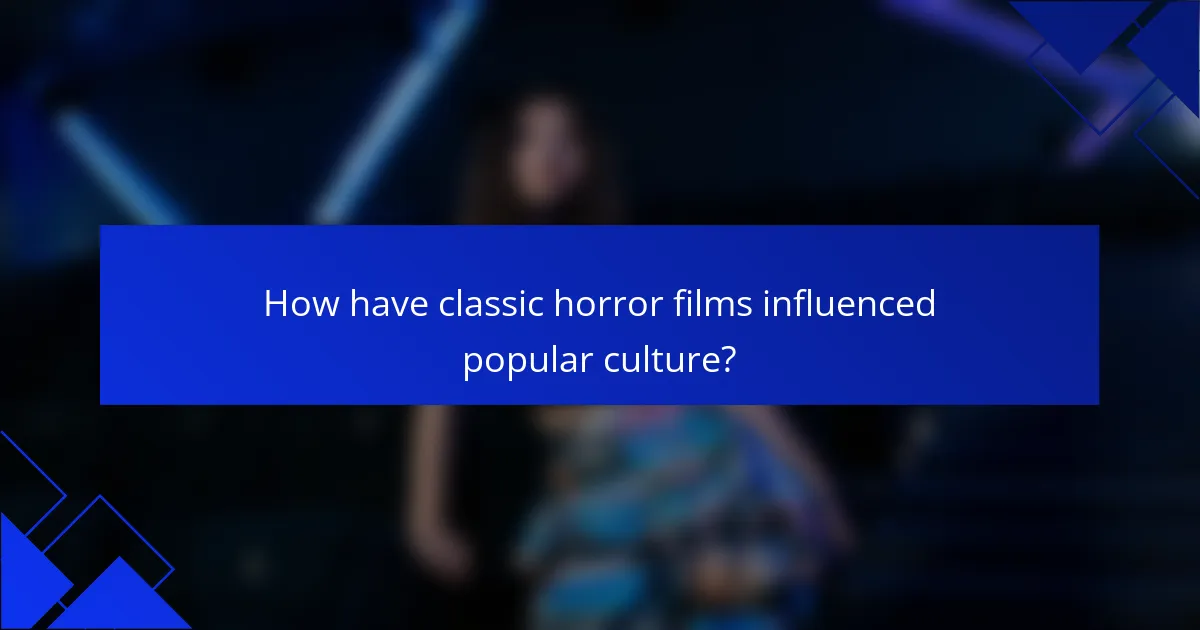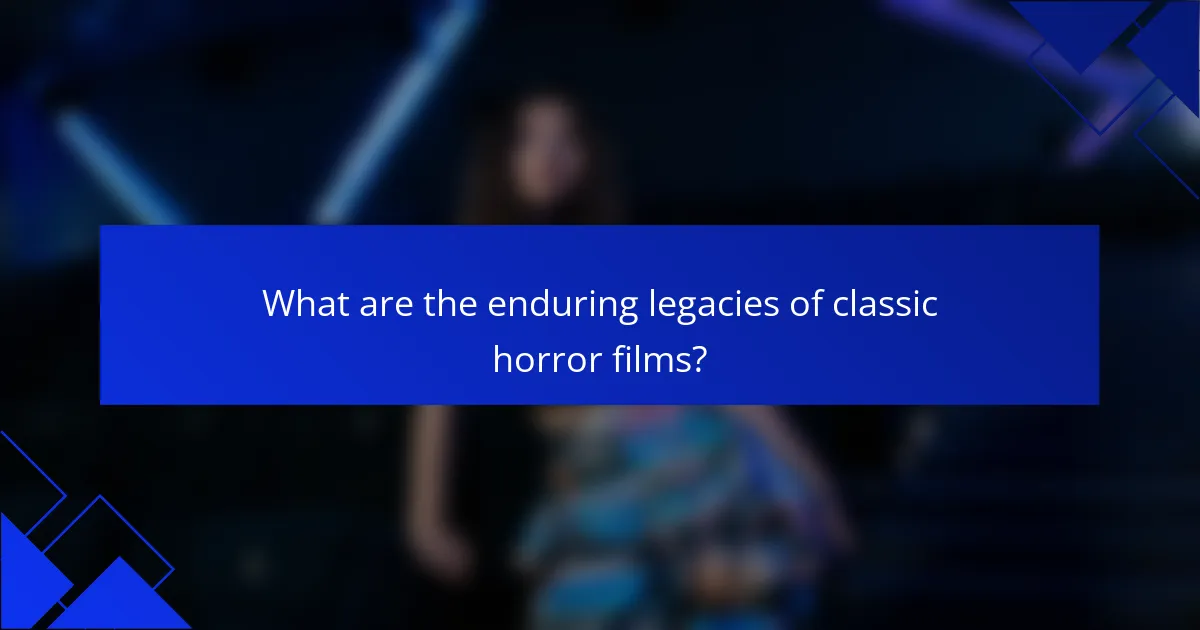
What defines classic horror films?
Classic horror films are defined by their ability to evoke fear through suspenseful storytelling and iconic imagery. These films often feature common themes such as the supernatural, monsters, and psychological terror. They utilize atmospheric settings, often in dark or isolated locations, to enhance the sense of dread. Notable examples include “Nosferatu” and “Psycho,” which have left lasting impacts on the genre. Classic horror films typically incorporate archetypal characters, such as the monster, the victim, and the hero. Their influence can be seen in modern horror, showcasing their enduring legacy. The use of innovative cinematography and sound design also contributes to their effectiveness in creating tension.
What are the key themes commonly found in classic horror films?
Key themes commonly found in classic horror films include fear of the unknown, isolation, and the struggle between good and evil. Fear of the unknown often manifests through unseen monsters or supernatural elements. Isolation creates tension, often placing characters in remote settings. The struggle between good and evil is depicted through the battle against malevolent forces. Other themes include madness, the consequences of scientific experimentation, and societal fears. These themes reflect historical anxieties and cultural contexts of the time. For instance, films from the 1930s often addressed fears stemming from the Great Depression. Classic horror films utilize these themes to evoke emotional responses and provoke thought.
How do fear and suspense play a role in these themes?
Fear and suspense are central to the themes in classic horror films. They create an emotional response that engages the audience. Fear evokes a sense of danger, while suspense builds anticipation for what may happen next. This combination keeps viewers on edge, enhancing their experience. Classic horror films often use techniques like eerie music and unexpected plot twists to amplify these feelings. For example, Alfred Hitchcock’s “Psycho” employs suspense through the famous shower scene, heightening fear with its shocking violence. The effective use of fear and suspense contributes to the lasting impact and cultural significance of these films.
What psychological aspects do classic horror films explore?
Classic horror films explore various psychological aspects, including fear, anxiety, and the human psyche’s darker elements. They often depict the struggle between good and evil, reflecting internal conflicts. The portrayal of monsters symbolizes repressed fears and societal anxieties. Classic horror evokes primal emotions, triggering responses rooted in survival instincts. Research indicates that these films can serve as a safe space for confronting fears. Studies show that horror can lead to catharsis, allowing viewers to process emotions. Additionally, the genre often examines themes of isolation and madness, highlighting the fragility of mental health. Overall, classic horror films provide insight into the complexities of human emotion and behavior.
What iconic monsters are featured in classic horror films?
Iconic monsters featured in classic horror films include Dracula, Frankenstein’s Monster, the Mummy, and the Wolf Man. Dracula, created by Bram Stoker, is a legendary vampire known for his bloodsucking behavior. Frankenstein’s Monster, from Mary Shelley’s novel, represents the consequences of unchecked scientific ambition. The Mummy, often depicted as a reanimated corpse, reflects themes of ancient curses and resurrection. The Wolf Man, originating from folklore, embodies the struggle between humanity and primal instincts. These monsters have become cultural symbols, influencing countless adaptations and interpretations in cinema.
How do these monsters reflect societal fears of their time?
Monsters in classic horror films reflect societal fears by embodying contemporary anxieties. For instance, Dracula represents fears of the unknown and foreign invasion during the late 19th century. The creature in Frankenstein symbolizes concerns about unchecked scientific progress and its potential consequences. Godzilla emerged from post-war fears of nuclear destruction and environmental catastrophe. Each monster serves as a metaphor for specific societal issues, illustrating how horror reflects the collective psyche of its era. Historical context reveals that these fears were prevalent during the times these films were produced, making the monsters relevant to their audiences.
What are the origins of these iconic monsters?
The origins of iconic monsters in classic horror films often stem from folklore, literature, and societal fears. For instance, Dracula originates from Bram Stoker’s 1897 novel, inspired by Eastern European vampire legends. Frankenstein’s monster comes from Mary Shelley’s 1818 novel, reflecting themes of creation and humanity. The Mummy is based on ancient Egyptian mythology, particularly the fears surrounding tomb robbing and curses. Werewolves trace back to European folklore, symbolizing the duality of human nature. Each monster embodies cultural anxieties of its time, illustrating humanity’s struggles with mortality, identity, and the unknown.

How have classic horror films influenced popular culture?
Classic horror films have significantly influenced popular culture by shaping genres, inspiring fashion, and creating iconic characters. These films introduced archetypes like the vampire and the zombie, which have become staples in media. For example, “Dracula” and “Frankenstein” set the foundation for countless adaptations and reinterpretations. The imagery and themes from these films have permeated literature, television, and video games. Fashion trends, such as gothic styles, emerged from the aesthetics of classic horror. Additionally, classic horror films have contributed to Halloween traditions, popularizing costumes and decorations. Their impact is evident in contemporary films and series that pay homage to these early works. Overall, classic horror films have left an indelible mark on various aspects of popular culture.
What impact have classic horror films had on modern cinema?
Classic horror films have significantly influenced modern cinema. They established foundational tropes and themes that persist in contemporary storytelling. Iconic elements include the use of suspense, psychological tension, and the exploration of fear. Films like “Psycho” and “Nosferatu” introduced innovative cinematographic techniques and narrative structures. These classic films also shaped character archetypes, such as the monster and the final girl. Modern filmmakers often pay homage to these classics through references and remakes. The horror genre today continues to evolve, building on the groundwork laid by earlier films. This legacy is evident in the popularity of horror franchises and the resurgence of interest in psychological horror.
How do contemporary films pay homage to classic horror?
Contemporary films pay homage to classic horror through various techniques. They often reference iconic characters and storylines from earlier films. For example, “It Follows” incorporates themes of inevitability reminiscent of classic slasher films. Additionally, filmmakers use visual styles that echo the cinematography of classic horror. The use of practical effects instead of CGI is another nod to earlier techniques. Sound design frequently mimics the atmospheric tension found in vintage horror. Many contemporary films also include Easter eggs that fans of classic horror recognize. Directors like Jordan Peele openly cite classic horror as inspiration for their narratives. This blending of old and new creates a dialogue between eras in the genre.
What are some notable remakes of classic horror films?
Notable remakes of classic horror films include “The Thing” (1982), which reimagines John Carpenter’s take on the 1951 film “The Thing from Another World.” “The Fly” (1986) is a remake of the 1958 film of the same name, directed by David Cronenberg. “Halloween” (2007) is a reworking of John Carpenter’s original 1978 film. “Psycho” (1998) is a shot-for-shot remake of Alfred Hitchcock’s 1960 classic. “A Nightmare on Elm Street” (2010) revisits the 1984 original. Each of these remakes has garnered attention for their modern interpretations and updates of the source material.
How do classic horror films shape societal perceptions of fear?
Classic horror films shape societal perceptions of fear by reflecting cultural anxieties and societal norms. These films often embody the fears prevalent in their respective eras. For example, films like “Dracula” and “Frankenstein” address themes of isolation and the unknown. They resonate with audiences by exploring human vulnerabilities. The portrayal of monsters often symbolizes societal fears, such as the fear of the other or the consequences of unchecked ambition. Research shows that horror films can serve as a cathartic experience, allowing viewers to confront their fears in a controlled environment. This catharsis can lead to a deeper understanding of societal issues. Studies indicate that classic horror films have influenced public discourse around topics like morality and ethics. Overall, classic horror films play a significant role in shaping how society perceives and understands fear.
What role does horror play in cultural storytelling?
Horror plays a significant role in cultural storytelling by reflecting societal fears and anxieties. It serves as a medium for exploring taboo subjects and confronting the unknown. Through horror narratives, cultures can process trauma and societal issues, such as violence or death. Historical examples include the use of horror in folklore to teach moral lessons. Additionally, horror often acts as a catalyst for community bonding during shared experiences of fear. This genre also provides a safe space for audiences to confront their fears vicariously. By engaging with horror, individuals can gain insights into their own psyche and cultural identity. Overall, horror functions as both a mirror and a lens for understanding human experience within cultural contexts.
How have classic horror films contributed to discussions on morality and ethics?
Classic horror films have significantly contributed to discussions on morality and ethics by presenting moral dilemmas and societal fears. They often explore themes like good versus evil, the consequences of human actions, and the nature of monstrosity. For instance, films like “Frankenstein” question the ethics of creation and responsibility. “Dracula” delves into issues of seduction and the loss of innocence. These narratives reflect societal anxieties about technology, sexuality, and the unknown. By embodying these themes, classic horror films engage audiences in moral contemplation. They prompt viewers to reflect on their values and societal norms. This engagement has led to ongoing discourse in academic and popular contexts.

What are the enduring legacies of classic horror films?
Classic horror films have left enduring legacies that influence modern cinema and culture. Their themes often explore human fears, societal issues, and the supernatural. Iconic characters like Dracula and Frankenstein’s monster continue to inspire adaptations and references. These films established genre conventions that shape horror storytelling today. Innovations in special effects and makeup techniques originated from classic horror. They also sparked discussions about morality, taboos, and existential dread. The cultural impact includes influencing fashion, music, and art. Classic horror films remain a touchstone for filmmakers and audiences alike, demonstrating their lasting significance.
How do classic horror films continue to resonate with audiences today?
Classic horror films resonate with audiences today due to their timeless themes and cultural significance. These films often explore universal fears such as mortality, the unknown, and societal anxieties. For example, “Dracula” and “Frankenstein” address themes of isolation and the consequences of unchecked ambition. Their iconic monsters have become symbols in popular culture, influencing countless adaptations and references. Furthermore, the nostalgia associated with classic horror films attracts new generations of viewers. Studies indicate that horror films, including classics, release endorphins, providing a thrilling experience. This emotional response keeps audiences engaged and returning to these films. Classic horror films maintain relevance through their ability to reflect contemporary societal issues, making them enduringly impactful.
What elements make classic horror films timeless?
Classic horror films remain timeless due to their universal themes, relatable characters, and innovative storytelling techniques. Universal themes such as fear of the unknown resonate across generations. Relatable characters, often facing moral dilemmas, allow viewers to connect emotionally. Innovative storytelling techniques, such as suspense and atmosphere, engage audiences effectively. Iconic monsters symbolize deeper societal fears, making them memorable. The use of practical effects creates a lasting impact, as seen in films like “Psycho” and “Frankenstein.” Additionally, the cultural context of these films often reflects societal anxieties, enhancing their relevance over time. These elements collectively ensure that classic horror films continue to captivate audiences today.
How do fan communities keep the legacy of classic horror alive?
Fan communities keep the legacy of classic horror alive through active engagement and preservation efforts. They organize screenings of classic films, allowing new audiences to experience these works. Online forums and social media groups facilitate discussions about themes and characters. These communities create fan art and fan fiction, expanding the narrative universe of classic horror. They also publish blogs and podcasts that explore the history and impact of these films. Events like horror conventions celebrate classic horror, bringing fans together to share their passion. Additionally, fan-led preservation projects restore and archive classic films for future generations. Such initiatives ensure that the cultural significance of classic horror remains relevant and accessible.
What lessons can be learned from classic horror films?
Classic horror films teach valuable lessons about fear, morality, and human nature. They often illustrate the consequences of hubris, as seen in “Frankenstein,” where Victor’s ambition leads to tragedy. These films highlight the importance of community and cooperation in overcoming evil, as portrayed in “Night of the Living Dead.” They explore the psychological aspects of fear, revealing how it can drive individuals to irrational behavior. Classic horror also addresses societal fears and anxieties, reflecting cultural issues of their times, such as the fear of the unknown. The use of suspense and atmosphere in these films shows the power of storytelling in evoking emotions. Ultimately, classic horror films serve as cautionary tales that resonate with audiences across generations.
How can filmmakers draw inspiration from classic horror themes?
Filmmakers can draw inspiration from classic horror themes by analyzing the psychological fears they evoke. Themes such as isolation, the unknown, and the supernatural are prevalent in classic horror. These elements resonate deeply with audiences, tapping into universal anxieties. Classic films like “Nosferatu” and “Psycho” exemplify the effectiveness of these themes. The use of atmosphere and suspense is crucial in creating tension. Techniques like shadow play and sound design enhance the horror experience. By reinterpreting these themes, filmmakers can create fresh narratives while honoring the genre’s roots. This approach can lead to innovative storytelling that captivates modern viewers.
What tips can viewers take away from classic horror film experiences?
Viewers can take several tips from classic horror film experiences. First, they should appreciate the use of suspense and atmosphere. Classic horror films often build tension through sound design and lighting. Secondly, viewers can learn the importance of character development. Strong characters enhance emotional investment in the story. Thirdly, recognizing iconic tropes can deepen appreciation. Many classic horror films use familiar themes like isolation and the unknown. Additionally, viewers should note the cultural context of these films. Understanding the era’s societal fears can enrich the viewing experience. Lastly, embracing the artistry of practical effects can lead to greater admiration. Classic horror often relied on innovative techniques that shaped the genre.
The main entity of the article is classic horror films, which are characterized by their ability to evoke fear through suspenseful storytelling and iconic imagery. The article explores key themes such as fear of the unknown, isolation, and the struggle between good and evil, while also examining the psychological aspects these films portray, including anxiety and societal fears. It highlights iconic monsters like Dracula and Frankenstein’s Monster, discussing their origins and the societal anxieties they reflect. Additionally, the article addresses the cultural impact of classic horror films on modern cinema, fan communities, and the lessons they impart about morality and human nature.